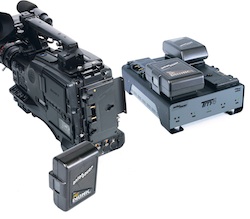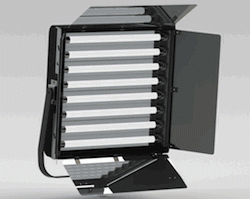
Although camera design is becoming more power efficient, high-end HD and digital cinematography cameras still require a lot of energy. Add on-camera lights, wireless attachments for microphones, camera control and links, plus LCD monitors, and the demands were rising higher than existing batteries could cope. So, this year’s cell of new batteries are truly power packed. David Fox reports.
Vitec’s battery brand, Anton/Bauer, has a new high-current draw Li-ion battery, the Dionic HC, which is capable of up to 10Amps of current draw. This is aimed at cameras like the Sony F35, which have a very high current draw at boot up. “This battery is the only one that can do that in a small package,” claimed Joop Jansen, CEO of the Vitec Group’s Broadcast Systems Division.
The Dionic HC is designed to handle high-current applications, with a claimed 80% higher capability than rival products. It provides 10 amps for high current draw applications, and a 91 Watt-hour version can operate a 40W HD camcorder for more than two hours, and weighs 795g.
“Cameras and other pieces of equipment have gone up in power requirements as digital technology has spread,” explained Joe Murtha, Anton/Bauer engineering manager. “By introducing the Dionic HC cell pack, we are able to offer users the level of support required for powering such products.”
Anton/Bauer also has a new, faster battery charger: the TM4 can charge up to four batteries at once, and is up to twice as fast as the existing TWQ charger. It doubles as an AC power supply, with 70W available via a 4-pin XLR connection. The power supply can be used simultaneously with the charger, allowing three batteries to be charged while operating from AC mains.
The TM4 will fully charge a Dionic 160 battery in 3.5 hours, a Dionic 90 in three hours, a HyTRON 100 or 140 in two hours, a ProPac Series in one hour, the HyTRON 50 in two hours, and one hour for the TrimPac Series. It operates off a 100-240v AC supply (50/60Hz), and has an individual charge position status LED for each battery, while the internal battery management software can be updated from a remote location using a specialized USB-compatible programming cable.
One of its first buyers was UK hire company, Procam Television, which bought 250 Dionic HC batteries and 50 TM4s. Its managing director, John Brennan, called the HC and TM4 combination “a match made in heaven. The Dionic HC’s latest cell technology for high current draw applications is crucial when it comes to today’s power-hungry camcorder attachments, including wireless monitors, wireless microphones and on-board camera lights,” he added.
@subhead:A power cycle made for two
@copy:Anton/Bauer claims its new Tandem 150 System is ‘the smallest and lightest charger and on-camera power supply package available on the market.’ The power/charger works separately from the power supply, allowing a user to simultaneously charge a battery as well as power a camera at 75 Watts. When the 75W draw is exceeded, the system automatically stops charging and performs solely as a power supply, but if the camera is turned off or the load is reduced below 75W, it resumes charging.
It can operate from 90 to 250 volts AC, 50-60-Hz, with the use of a car’s cigarette lighter, or with Anton/Bauer’s Solar Panel. It also allows for on-camera lighting, a feature unavailable with the existing Tandem 70 system.
“With so many options for power supply compatible with this unit, users working on-location or in remote areas will especially appreciate” it, said Shin Minowa, VP of marketing and business development. It “meets the power requirements of today’s power-hungry HD cameras without adding a lot of extra weight to the camera. We certainly focused on ease of use for this system, and with the separation of the power/charger device from the power supply, we’re able to reduce 80% of the heat coming off the back of the camera, providing added comfort.”
Top draw
Frezzi Energy Systems has introduced two new 150Wh batteries that are claimed to be ‘the most powerful NiMH series camera batteries that you can buy at any price’. The 14.4v HD-150 can handle high discharge rates up to 200W, offers good cycle life, and weighs 2.45kg.
There is also a slimmer, lighter (1.3kg) HD camera battery, the HD-60 Mini Brick. The 14.4v 60Wh unit can handle up to 80W. The new batteries have a four-year warranty and no travel restrictions.
They are designed for cameras with an Anton/Bauer bracket and are available with (HD-150EG/ HD-60EG) or without (HD-150/HD-60) an advanced energy gage displaying capacity by percentage. The energy gage has a sleep mode when not in use to save power.
Its 150Wh Power Packages include either a Dual Simultaneous charger and two HD Camera batteries or an Advanced Quad All chemistry charger with four HD camera batteries.
The new NP-35 from Hawk-Woods is a unique half-height Lithium-Ion NP1-style battery, aimed at providing sound recordists, in particular, with a lightweight, space-saving unit.
It produces 35W output, making this “stubby battery” a useful alternative to a regular sized Ni-Cad battery, such as Hawk-Woods’ 29W SNP-29, as it offers 20% more power.
With identical width and depth dimensions, the NP-35 is similarly compatible with Hawk-Woods’ NP-65 and NP-70 batteries, and can be utilised with its range of NP1 chargers or shoe power adaptors.
Also new is its Reel Power Film Camera System for high voltage, high speed film cameras, such as the Phantom, without the size and weight of the batteries usually used for these cameras. The RP Lithium-Ion and Manganese Lithium-Ion on-board battery packs use V-Mount fittings and come in 26v or 30v versions. Power is transferred to the camera via a 3-pin XLR flying lead. Additional power distribution is available via a Power-Con (D-Tap) socket and 3-pin Fischer connector. The RP Camera Adaptor allows the high capacity batteries to be used with conventional 12v broadcast cameras, via a Sony V-mount.
There are also portable RP battery chargers, with two V-Mount type channels, to fast charge the Manganese RP-90M or RP-100M in about one hour. Two RP-140 or RP-180 batteries can be charged in around four hours each.
Endura endures
IDX Technology has added two new V-Mount Lithium Ion batteries to its Endura range. The 88Wh HL9 and HL9S can cope with a sustained high current draw up to 10A / 120W. The E-HL9 includes PowerLink, allowing a second battery to be clipped on to the first to extend continuous run-times and double capacity (to at least 176Wh).
Both models use a new grade of durable lithium ion cells, giving a longer lifecycle compared to other models, so users can expect to achieve upwards of 500 cycles.
The E-HL9 also has Digi-View, which communicates with the camera viewfinder, to show battery capacity remaining as well as storing key performance data (discharge cycles, remaining capacity and peak loads) for IDX’s Battery Management Software.
The batteries can be used in temperatures as low -20°C without the sharp voltage drop-off that often occurs with Li-ion batteries.
IDX has released two new batteries for Panasonic’s professional camcorders. The SSL-VBG50 Li-ion battery offers 37Wh / 5000mAh capacity and employs a secure battery/camera interface which is recognised by the AG-HMC151 and AG-HMC71 AVCCAM camcorders as an authorised power source, and should give them more than three hours continuous runtime. The SL-VBD50 Li-ion battery offers the same capacity and is compatible with Panasonic’s DVX, HVX and HPX camcorders.
The small LC-VWP charger offers two-channel simultaneous quick charging for both batteries as well as certain Panasonic 7.4v batteries.
IDX is also targeting users of Sony’s EX3, with its new A-E2EX3 Adaptor Bracket to take an IDX V-Mount battery (two Endura-10S batteries, a charger and the adaptor are available as a kit). Also new is the A-MWR bracket, which attaches directly to the V-Mount of virtually any SD or HD ENG camera and hold a wireless receiver, portable HDD recording device and other accessories.
Polymer Li-ion
Chinese battery manufacturer, Jiade Energy Technology, has introduced a new 85W Polymer Li-ion battery for video cameras: the Beillen BL-P-AN85/BL-P-BP85 weighs 620g, has a rating voltage of 14.8v and capacity of 5.8Ah.
It features a standard power tap connector, to power a camera light directly, and a four-level LED to show remaining power.
Jiade has also introduced a 190W battery system that splits in two. The Beillen Buddy (AN-G-AN190 and BP-G-BP190), has a rating voltage of 14.8v, capacity of 6.6Ah/95Wh (x2), weighs 1500g, and can take a maximum load of 95W.
The buddy system can be split in two and meets International Air Transport Association regulations. It has both a four-level LED and an LCD to show remaining power. It also has a standard power tap connector.
Swit Electronics has introduced two high-power battery models. The 14.4v 88Wh Li-Ion units come in either V-mount (S-8082S) or Gold mount (S-8082A) versions, and have LED power remaining indicators, and a newly designed DC output to power the camera and a light simultaneously. Both weigh 760g.
Also new is the S-8U62, a 63Wh intelligent Li-ion battery with a multiple protective circuit design for Sony’s EX1 camera. It has a four-level remaining power indicator, a 14.4V D-tap power socket, and weighs 420g.
A further Sony-style Li-ion model is the new 47.5Wh S-8972, for DV and HDV camcorders such as the Z1 or PD-190. It has a four-level power indicator, 7.2v DC output socket, and weighs 300g, There is a similar Panasonic-style model (the S-8D62), for such cameras as the HVX200 and AGDVC180A.







